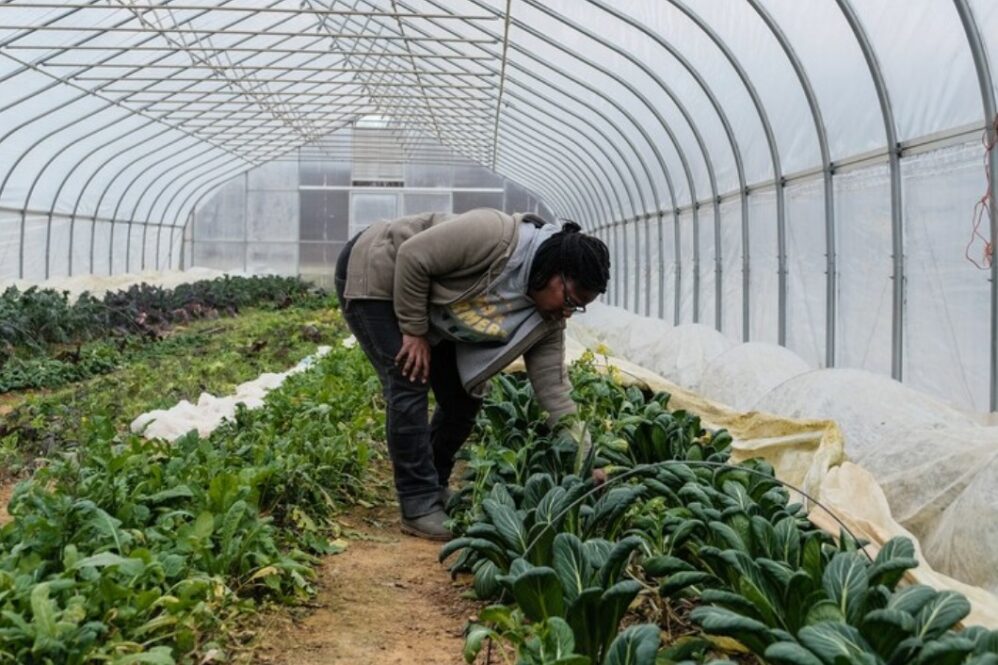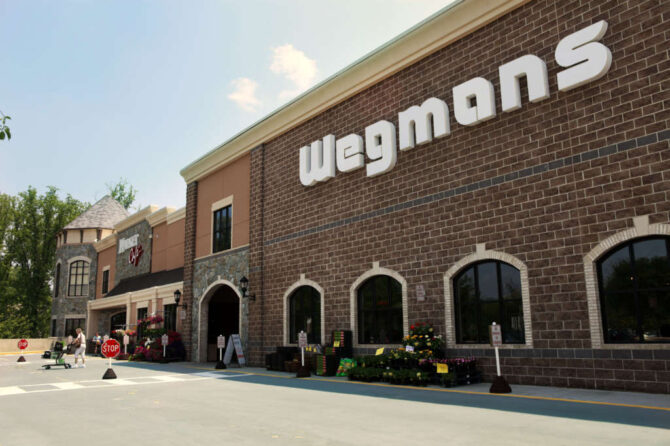WASHINGTON POST: When the time came for Gale Livingstone to buy farmland, the familiarity and prestige of Prince George’s County called. It was consequential, majority-Black and it used to be home for Livingstone, 50, a Largo High graduate who is known as “Farmer Gale.”
After about a year of searching for land while driving around the county and writing letters inquiring about plots for sale, she would eventually “luck up” on 53-plus acres in Upper Marlboro that were once prime tobacco farming land in another era of the county.
It’s been hard since. The pandemic added fresh stress, and new debt left Livingstone with doubts about the choice to launch Deep Roots Farm. Still, she wanted to farm.
“I feel like if I’m going to work like this and I’m going to grow this food, I want my people to be eating the food,” Livingstone said.
Her hardships — struggling to find and buy land without generational wealth, extensive credit history and limited land — are among the reasons only 1 in 6 farmers in Prince George’s County is Black when nearly 2 in 3 county residents are. Even here, Black farmers don’t see their locs or shades of melanin represented in a space where archetypes range from portly White men in overalls to slim and bearded White hipsters in plaid.
State, local and federal officials say they want to support farmers like Livingstone, who recently spoke at the reveal of a partnership funded by the U.S. Agriculture Department to help women and minority farmers. The irony of the federal government stepping up to help, after centuries of shutting Black farmersout of the agricultural industry, is not lost on Livingstone. While the racial reckoning of 2020 also trickled down to farmers of color, with the 2022 launch of the USDA’s Equity Commission and the increase of grants targeting women and racial minorities, those efforts are running up against centuries of disinvestment.
The $3.25 million USDA-backed program, a collaboration between county government entities, Bowie State University and the University of Maryland Extension, is a small step forward for Black farmers contending with a legacy of discriminatory practices that still leave them struggling to find land, money to buy it and support to sustain it, some Black farmers and landowners said in interviews.
Doug Adams, owner of New Brooklyn Farms in Mount Rainier, said he’s encouraged by the new initiatives to address disparities in farming even though the issue remains complex without many easy solutions or opportunities to pursue a path that has become increasingly challenging for all small farmers.
“It does not remedy things like land access and the feasibility for someone who is a mom with two kids to do this full time,” he said, noting he’s very unlikely to quit his job in tech to solely focus on farming. “If they ever want to get into farming, they have to take so many steps back. There’s a whole other set of underlying obstacles that people of color face.”
No land to inherit
When Black students in a class for new farmers started listing the barriers to their dreams, Andrea Crooms listened.
Most often, the problems involved money and land access. That made sense to Crooms,director of the Department of the Environment for Prince George’s County, who was enrolled in the course through the University of Maryland Extension, a statewide, nonformal education system within the College of Agriculture and Natural Resources.
“We know that’s exacerbated in the African American community because at best, we are at one generation of multigenerational wealth right around here, at least,” Crooms said. “The reality is the majority of folks don’t have land to inherit.”
America is home to a racial wealth gap that, according to the Federal Reserve, leaves the typical White family with eight times the wealth of a Black one. Participants in the farming course were familiar with what contributed to this gap, stretching back centuries to the country’s original sin — when enslaved people’s mastery of the land was exploited for cash crops of tobacco, rice and cotton.
Once emancipated, some Black people were able to buy or were gifted land from their previous owners while many others walked away with nothing and the promise of 40 acres and a mule, said Psyche Williams-Forson, author and chair of the Department of American Studies at the University of Maryland College Park.
Black people who did own land and were able to sustain themselves and their family through farming still faced the threat of having their property ripped away through physical intimidation or violence and also through legal loopholes, she noted. The federal government, even when trying to correct its past wrongs against people of color, has been slow to fully realize its promise. Biden included $4 billion in the 2021 American Rescue Plan that would help pay off farm loan debt for socially disadvantaged farmers.
Up to 13,000 Black and other minority farmers could’ve seen relief through the effort, but many White farmers and lawmakers sued, arguing that the payments were reverse discrimination. The money has yet to be seen by Black and other minority farmers and a group of minority farmers has since chosen to take the federal government to court for going back on its word.
“You’ve got Black folks who are still trying to just get land, right? It’s a vicious cycle,” Williams-Forson said. “They want us to be thankful every time we get these pockets of money.”
Black farmers are just 1 percent of the country’s 3.4 million producers, primarily living in southeastern and Mid-Atlantic states, according to 2017 data. Many of them were found to be older and more likely to have served in the military with sales of their products accounting for less than a half-percent of total U.S. agriculture sales.
Crooms wants to narrow some of those gulfs with the grant. Between 20 and 40 existing farmers could receive up to $50,000, with new farmers being able to receive up to $100,000. In the coming weeks, about 500 surveys will be sent out to existing farmers and those interested in farming to help identify grant recipients, Crooms said.
About 70 percent of the $3.25 million will go to underserved communities, which Crooms said has a relatively loose definition at the moment.
“My immediate focus, of course, is on Black and African American farmers and immigrant farmers, on women farmers, on people who don’t have that multigenerational wealth,” Crooms said. “But there’s a lot of other folks I have a feeling who are underserved.”
Goals
Falani Spivey, owner of Byrd’s Nest Box, is likely to apply for a grant, though she said she didn’t know about it until she spoke with The Washington Post, pushing her to question how information will reach people like her — the grant’s intended audience.
The Howard University graduate questions how the funds will reach older Black farmers who might not be tech savvy, especially as more programs and grants pop up with the intention to help that demographic, she said.
She would use the money to cultivate the 1½-acre plot she’s leasing in Upper Marlboro through the Urban Farm Incubator, a program by Eco City Farm and other local partners that helps farmerswith business plans, land and equipment needs as well as mentorship.
Spivey, 37, could also use the money to scale her operations to serve the customer base she built through the pandemic, curating boxes of seasonal vegetables, baked goods and hot sauces grown from seeds native to land her ancestors once cultivated off the coast of West Africa. Having her sauces placed in stores would also give her more time to work on her land, instead of hustling at farmers markets to sell her crops.
Spivey, a D.C. native who grew up around George Avenue NW, relocated to Prince George’s because of gentrification. She hopes to one day buy and cultivate enough land to quit being a freelance camera operator, but the dream can feel out of reach.
What could be gained by the program is not lost on Adams, whose land helped Spivey hone her skills before she broke ground on her newly leased plot, but he has concerns about the oversight and knowledge of the many players that could be involved based on his own experiences of getting started.
Adams was instrumental in getting two pieces of legislation passed that increased the footprint for urban farming in Prince George’s.Those updates to county code were brought about because the county’s Permitting, Inspections and Enforcement agency held up his ability to use a grant to help his farm, he said.
How grant funds are administered should be transparent, Adams said, and the people leading the program should be as knowledgeable about county codes as climate-smart tech.
In the meantime, Farmer Gale is waiting to see how the pilot program will be executed before exalting all its benefits.
It won’t be enough to help someone buy land in the county, but she hopes the program will come with a check and guidance about how to work and run a farm, which one of Crooms’s goals.
“This is barely a drop in the bucket, but what this does is it allows us to identify pathways to economic stability for farms so that we can do more,” Crooms said. “It’s a beginning and not at all a solution.”
Photo: Gale Livingstone inspects crops at her farm in Upper Marlboro, Md., on Jan. 26. Prince George’s County has launched a pilot program geared toward assisting women and minority farmers build sustainable practices. (Michael A. McCoy for The Washington Post)










